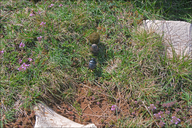|
|
click photo for larger file

Scarabaeus sacer
Sacred Scarab Beetle
|
Photographer: Dr. Amadej Trnkoczy
ID: 0000 0000 0920 2652 (2020-09-24)Copyright © 2020 Dr. Amadej Trnkoczy
|
|
INFORMATION PROVIDED WITH THE PHOTO
|
date of photo May 1, 2019
latitude 45.01150 longitude 14.67882
View on Google Maps.
location
Adriatic Sea, Island Krk; north of Mt. Veliki vrh, Kvarner bay (Rijeka region, Croatia)order
Coleoptera
class Insecta
notes Slo.: sveti skarabej, drekobrbec - syn.: Ateuchus retusus Brullé, Scarabaeus europaeus Motschulsky, Scarabaeus impius Fabricius - Habitat: stony high mountain flats, low grassland in patches among rocks; occasionally grazed by sheep; calcareous, skeletal ground: almost flat terrain; open, sunny, dry, hot during the summer and wind-swept place; average precipitations 1.500 ~ 1.600 mm/year, average temperature 10-12 deg C, elevation 454 m (1.490 feet), Sub-Mediterranean phytogeographical region. - Comment: The dung beetle Scarabaeus sacer was sacred to the ancient Egyptians. It was found in many old paintings and jewelry of that time. The beetles skillfully and in fierce hurry roll a peace of dung over grassland and sand ground. But this activity is not predominantly transport of the dung from place to place, as it may appear at first, but fashioning of a perfectly round ball by rolling it. Often male and female beetle work hard in tandem in a perfect coordination and mastering of equilibrium. They burry the balls after they are sufficiently firm and spherical in the ground and lay their eggs in them. Dung beetles can eat more than their own weight in a day and are therefore helpful to humans because they speed up the process of converting manure to substances usable by plants and reduce natural loss of nitrogen from the manure of the grazing cattle by burring it under the ground. Experiments have shown that the activity of these beetles on one hectare of a pasture may result in benefit of up to 130 kg of nitrogen (Ref.:2), which is essential for the fertility of the ground. - Ref.: (1) Fauna Europas, Bestimmungslexikon, George Westermann Velag, Brounschweig (1997), translated to Slovenian, Mladinaka Knjiga, Ljubljana (1981), pp 384. (2) https://www.researchgate.net/publication/287573589_Soil_nutrient_as_affected_by_activity_of_dung_beetles_Scarabaeus_sacer_Coleoptera_Scarabaeidae_and_toxicity_of_certain_herbicides_on_beetlescamera Sony ILCE6000 / Carl Zeiss Vario-Tessar E 16-70 mm/f4
contributor's ID # Bot_1188/2019_DSC05836 photo category: Animal - Invertebrate-Insect
|
MORE INFORMATION ABOUT THIS ANIMAL
|
| common names
Sacred Scarab Beetle (photographer)
View all photos in CalPhotos of Scarabaeus sacer Check Google Images for Scarabaeus sacer |
|
The photographer's identification Scarabaeus sacer has not been reviewed. Click here to review or comment on the identification. |
|
Using this photo The thumbnail photo (128x192 pixels) on this page may be freely used for personal or academic purposes without prior permission under the Fair Use provisions of US copyright law as long as the photo is clearly credited with © 2020 Dr. Amadej Trnkoczy.
For other uses, or if you have questions, contact Dr. Amadej Trnkoczy amadej.trnkoczy[AT]siol.net. (Replace the [AT] with the @ symbol before sending an email.) |
|
|
